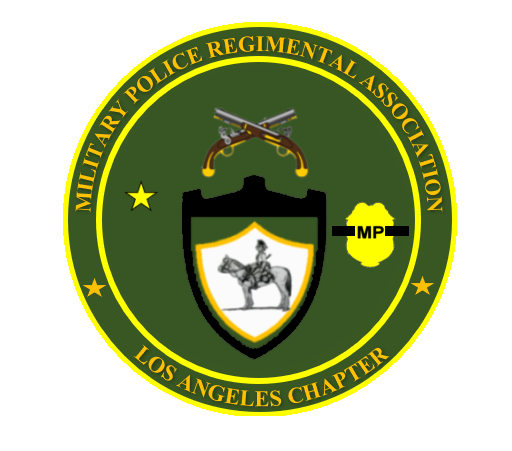U.S. ARMY MILITARY POLICE SYMBOLS
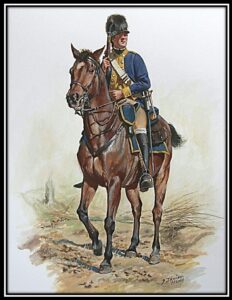
PROVOST LIGHT DRAGOONS
A trooper of Von Heer's Corps of Provost Light Dragoons , 1780-1781. Originally a military police type of unit , in the latter part of the war they served as General Washington's mounted guard.
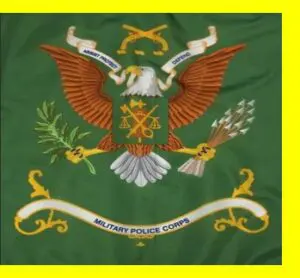
OFFICIAL FLAG OF THE MILITARY POLICE CORPS
The official flag of the Military Police Corps since 1923, the scroll with "Assist, Protect, and Defend", the motto of the Corps, in the mouth of th eagle, which also holds arrows in one claw and a peace branch in the other. On the eagle's chest is the crest of the MP Corps and below the eagle is a scroll with the words "Military Police Corps".
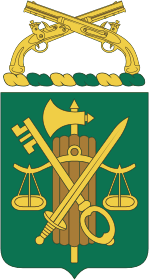
U.S. ARMY MILITARY POLICE COPRS CODE OF ARMS
HERALDIC ITEMS
Coat of Arms
Shield: Vert, a fasces palewise, axe or and rods proper (brown); thereover in fess a balance and in saltire overall a key with bow in sinister base and a sword with hilt in dexter base all of the second.
Crest: On a wreath of the colors, or and vert, a pair of crossed pistols of the first.
Motto: Assist, Protect, Defend.
Symbolism: Green and yellow are the colors of the Military Police Corps. The fasces are an ancient symbol of authority related to a Roman magistrate. The balance is symbolic of equal justice under law and the key signifies security. The sword represents the military. The Crossed Pistols are the symbol of Military Police Corps mission, to uphold the law and to keep order.
Distinctive Insignia
The distinctive insignia is an adaptation of the shield, crest, and motto of the coat of arms.
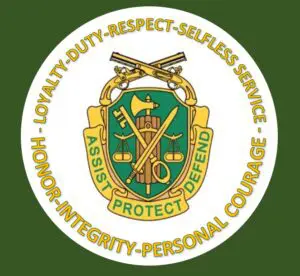
MILITARY POLICE CORPS CREST
Three Elements: Shield, Banner, and Pistols
Shield: Four Elements:
- Faces - a war axe bound within a bundle of rods by a red This was the symbol of authority in the Roman armies and was used to restore order and carry out punishments.
- Sword - represents military leadership and
- Key - represents security, both of personnel and vital military assets
- Scales - are the scales of justice representing the values of impartiality and
Banner: has "Assist, Protect, and Defend"
Assist - embodies the mission of aiding the commander in maintaining order and safeguarding the rights of soldiers and their families
Protect - the MP combat support role of protecting fellow soldiers and equipment on the battlefield
Defend - represents the combat mission of resisting, containing, and defeating the enemy to secure forward support and command and control elements to sustain and win the battle.
Crossed Pistols - These are the 1806 Harper's Ferry .54 caliber pistols adopted as symbolic of the MP Corps in 1923.
The banner surrounds the shield and is connected with the pistols to represent the unit of the Military Police Corps. This crest is surrounded by the Seven Army Values.
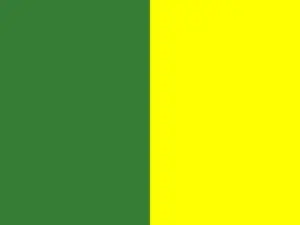
U.S. ARMY MILITARY POLICE COLORS
There are a few theories as to how the Military Police Corps acquired the colors of green and yellow.
- The uniform coats of the enlisted dragoons during the American Revolution were green with black trim and yellow buttons and button holes.
- In World War I the military police of the American Expeditionary Force in France wore a yellow and green cord on their hats.
- 'The MP Corps has the same lineage as the Calvary, both having originated with the Dragoons, thus the yellow of the Calvary was retained. The green was taken from the staff of the Provost Marshal Branch.
ln any case, in 1921 the colors of green and yellow were officially adopted for the Army Military Police with green on the field of yellow. In 194 l the colors were reversed with yellow on green.

MILITARY POLICE CROSSED PISTOLS
The above pistols are the Harper's Ferry Army Arsenal flint lock, Model 1906, caliber .54, were adopted as the insignia of the Corps of Military Police in 1923. The initial design consisted of crossed billy-clubs because that was the primary weapon of the MPs at that time but that symbol became confused with the field artillery crossed cannons. The next proposal was crossed maces, the medieval clubs, but they appeared to be potato mashers. The third proposal was crossed M-1911 .45 caliber automatic pistols but they appeared to be carpenter's squares. Then they agreed on the 1806 Model of the Harper's Ferry pistols and it was adopted. The order was signed by the Chief of Staff, General John J. Pershing in 1923 and became official.
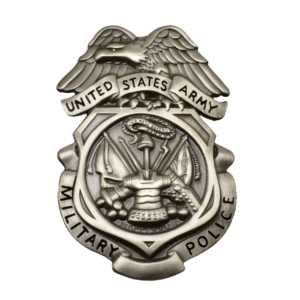
U.S. ARMY MILITARY POLICE BADGE
The development of the Military Police badge began in 1972 when the Provost Marshal General's office began considering proposed designs. The initial design incorporated the symbols of the 15th and 18th MP Brigades, the only two active brigades at the time. This was changed and the resulting badge was approved on 16 January 1975. The badge is sliver plated with an oxidized satin finish and has three distinct components:
- Shield - represents defense and the traditional police authority
- Eagle - perched on top of the shield represents alertness and vigilance
- Armament Crest - placed in the center replicates the crest of the official Department of the Army seal
